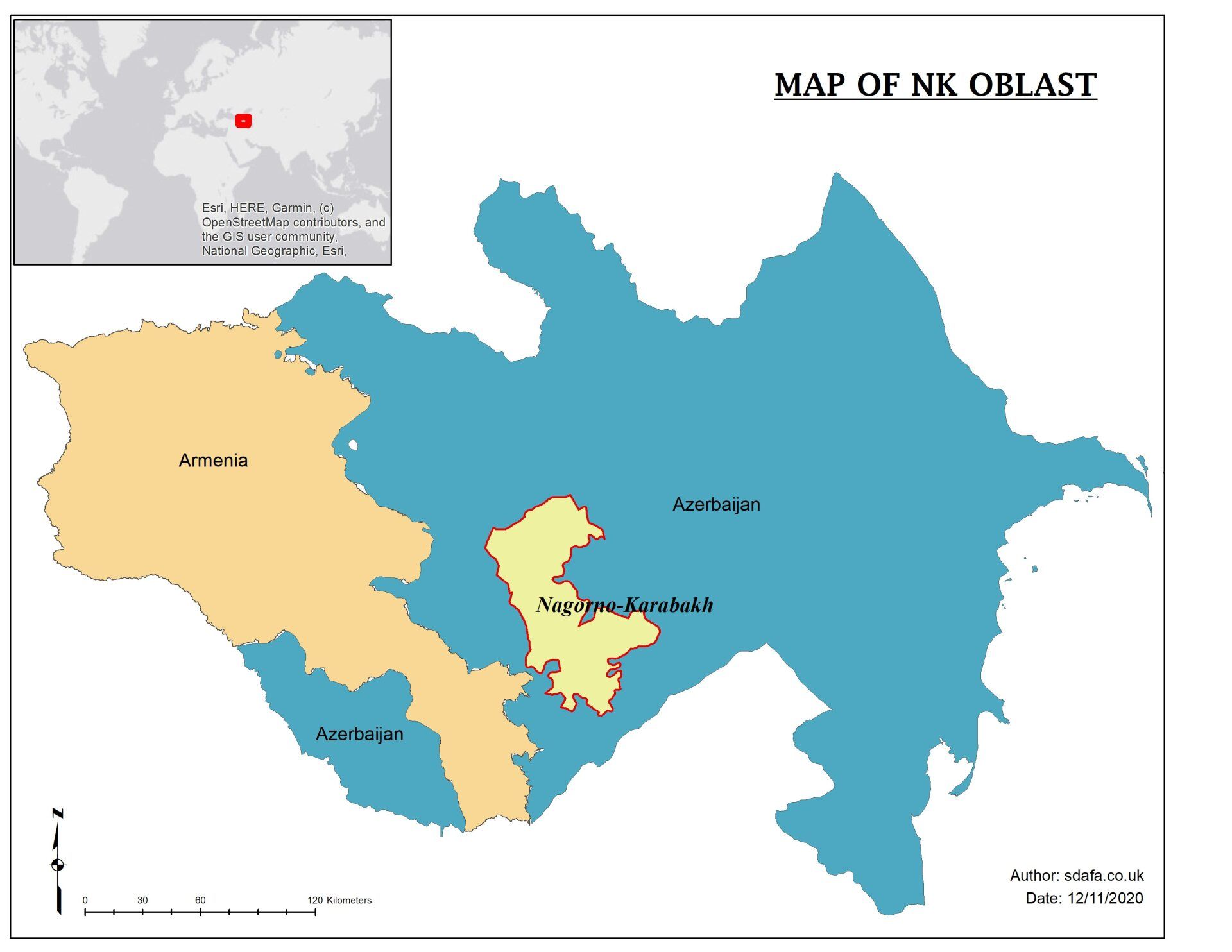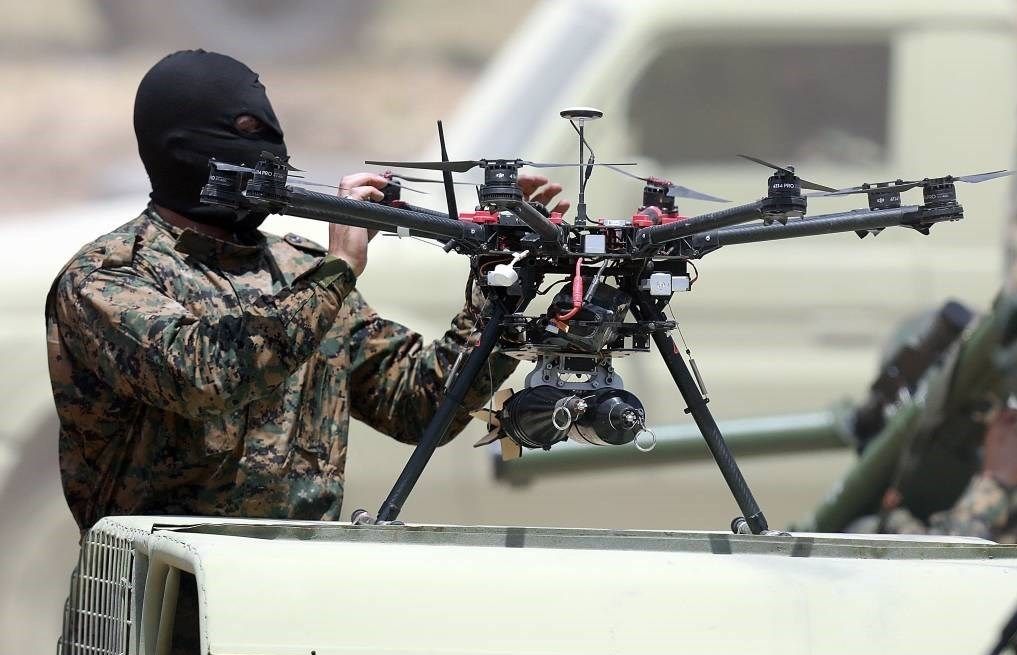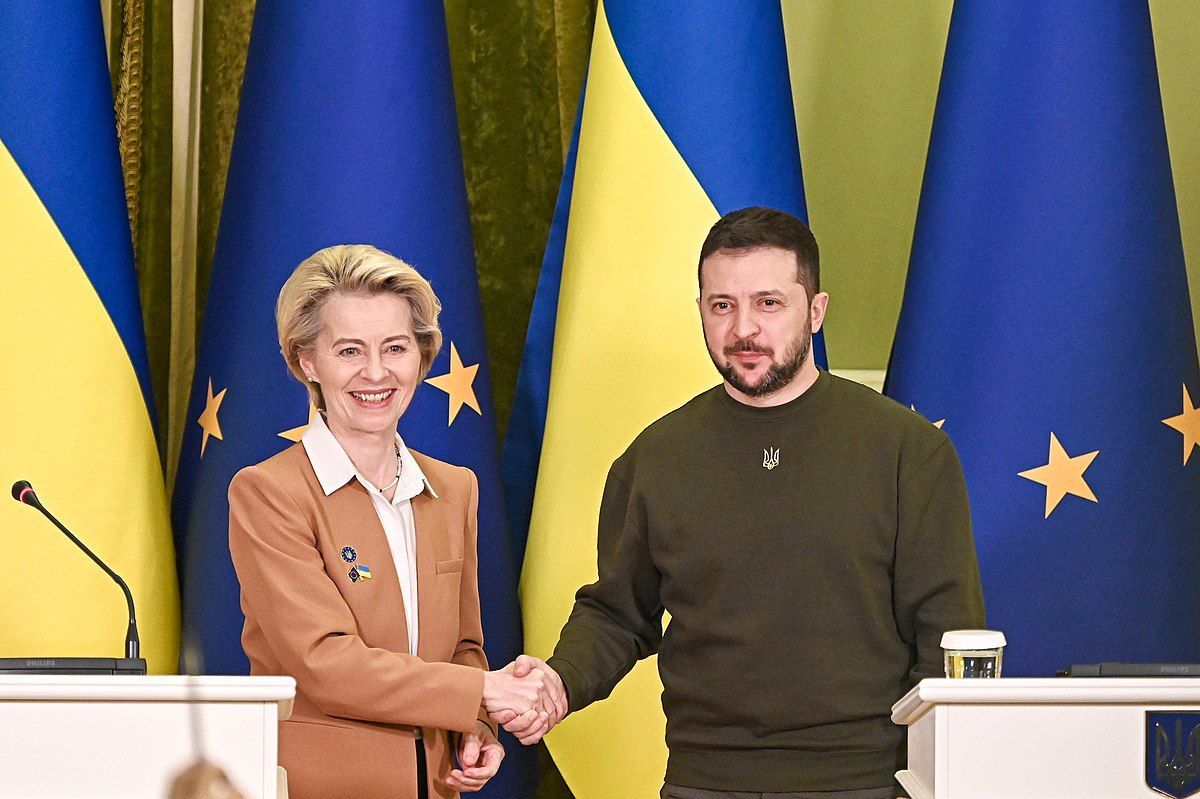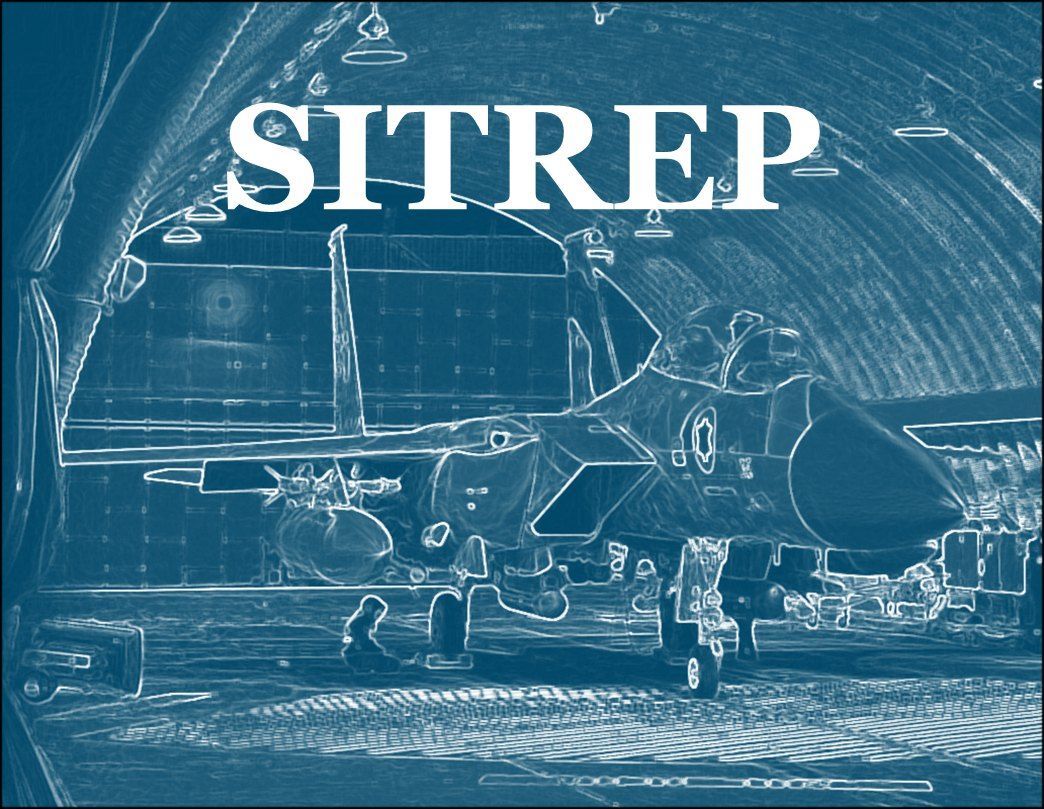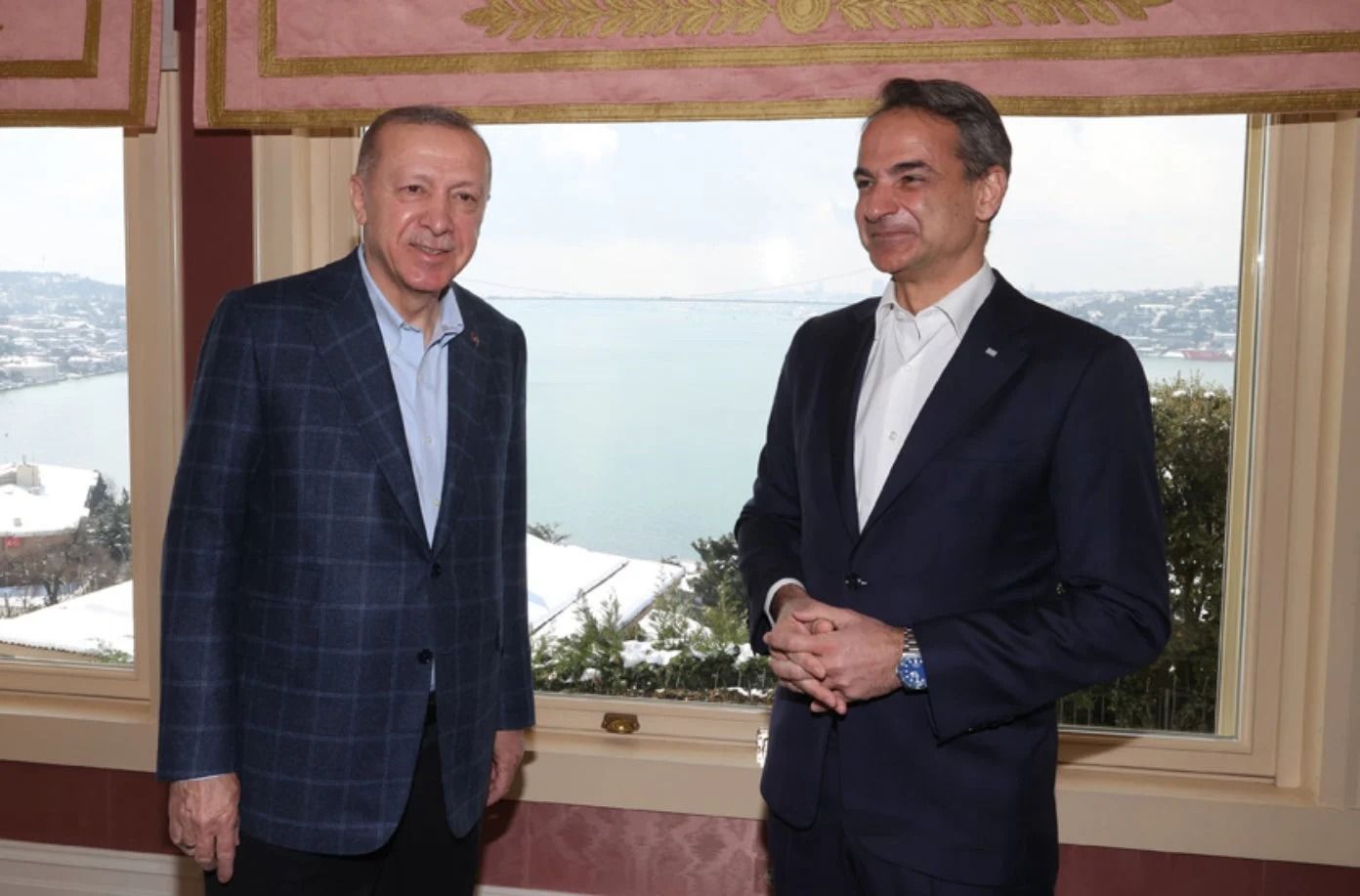18 December 2020
As the second Nagorno-Karabakh conflict draws to a close, what will the consequences be for the regional balance of power?
The Nagorno-Karabakh Oblast. This autonomous oblast within the Azerbaijani Soviet Socialist Republic was mainly inhabited by Armenians.
The territory remained relatively peaceful throughout the Soviet era, though the disintegration of the Soviet Union in the late 1980s would prompt the bitter conflict to surface once again. In December of 1991 the Armenians of Nagorno-Karabakh held a referendum, voting to secede from Azerbaijan and create an independent state. Armenia naturally supported the Armenians of Nagorno-Karabakh in their endeavour, and as a result full-scale war erupted between Azerbaijan and the separatist state. By 1994, Armenian forces had managed to gain control of most of the region and had also made territorial gains in seven Azerbaijani districts adjacent to Nagorno-Karabakh before a Russian-brokered ceasefire ended the war. The occupation of these districts has been a subject of controversy and certainly complicated the peace process; however Armenia maintains that these territories belonged to Armenia historically, and that Armenian control of them is essential for Nagorno-Karabakh’s security.
Following the 1994 ceasefire, Armenian separatists formed the Artsakh Republic. Artsakh is the historic Armenian name for the region.
The peace process that followed was largely a failure, mired by a marked lack of trust between both sides. Sporadic skirmishes continued to take place along the line of contact over the years, with the first drastic breach of the ceasefire occurring in April of 2016, often called the ‘Four-Day War.’ Though, the latest offensive launched by Azerbaijan on the 27 September proved to be of another nature entirely, once again plunging the nations into full-scale war. Through use of modern military technology (primarily Turkish and Israeli combat drones), Azerbaijani forces managed to break through Armenian defensive lines in the south, then advanced north in order to capture the strategic city of Shushi (Armenian)/ Shusha (Azerbaijani). Thereafter, Armenia was forced to agree to a new ceasefire agreement on 10 November.
The new ceasefire mediated by Russia proved to be a bitter pill to swallow for Armenia. The principal agreements made are as follows:
- Armenian forces must withdraw from all Azerbaijani districts adjacent to Nagorno-Karabakh
- Azerbaijani forces will be allowed to maintain their positions within the areas of Nagorno-Karabakh they occupy
- An economic transport link will be established across Armenian territory, connecting the Republic of Azerbaijan with its landlocked exclave the Nakhchivan Autonomous Republic
- A 1,960-strong contingent of Russian peacekeepers will be deployed along the new line of contact, with the establishment of a peacekeeping centre in charge of enforcing the ceasefire
Later, the Defence Ministers of Russia and Turkey signed a memorandum agreeing on the establishment of a joint Russian-Turkish monitoring centre in Azerbaijani territory
Whilst the deployment of Russian peacekeepers will maintain the ceasefire for some years, it is unlikely that we are seeing the complete resolution to this conflict. Ultimately, the status of Nagorno-Karabakh has yet to be resolved, and Armenia is entering this new stage of negotiations with far fewer bargaining chips than previously held. The Azerbaijani president, Ilham Aliyev, has already expressed his maximalist views on the conflict, stating that no special status will be granted to Nagorno-Karabakh and that “we would never allow for the establishment of a second Armenian state.” It is doubtful Armenia will capitulate entirely on this issue. Accordingly, in the years to come, another war may break out in the Caucasus.
Actors in the Second Nagorno-Karabakh War
Russia
Some observers have summarised this conflict as yet another proxy war between Russia and Turkey, but Russia’s relationship with Armenia is far less robust as Turkey’s relationship with Azerbaijan. Russia has been cautious not to tip the scales in favour of either Armenia or Azerbaijan, maintaining cordial relationships between both sides. One would assume that Russia has a tight military alliance with Armenia, as both are members of the Collective Security Treaty Organization (CSTO) and Russia already has a military presence within Armenia; the 102nd Military Base in Gyumri garrisons some 3,000 troops and the Russian 3624th Air Base is host to MiG-29s and Mi-24 attack helicopters. But things are not as they seem. The reality of the matter is that Armenia and Russia’s relationship is rather one sided. Russia exerts a massive amount of influence over Armenia, both politically and economically, and Russia only supports Armenia so far as to protect its own interests.
It is likely that Russian intelligence was aware of Azerbaijan’s planned offensive against the disputed region, yet Moscow made no attempt to warn Armenia prior to the start of hostilities. Similarly, Russia did not fully commit to providing Armenia with hardware capable of eliminating the threat from Azerbaijani drones. From this, we can assume that the post-war settlement serves to benefit Russia.
The agreement to allow Russian peacekeepers into Nagorno-Karabakh is undoubtedly a huge victory for Moscow. Nagorno-Karabakh remained the last disputed post-Soviet region that did not have Russian boots on the ground, and Russian president Vladimir Putin will likely exercise the leverage this provides. Now that Russian forces have positioned themselves within what is internationally recognised as Azerbaijani territory, and also controls the new economic transport link between Azerbaijan and Nakhchivan, Moscow now gains a great deal of authority over Baku. Though the ceasefire agreement stipulates that Russian peacekeepers are only allowed to stay within Nagorno-Karabakh for five years (which may be extended for another five years provided that neither of the parties object), there are many who are sceptical of whether or not they have any intention of leaving, drawing parallels with Russian presence in Moldova and Georgia. Although, Turkey’s ever increasing role within the conflict may counter such an objective.
The agreement also results in an increase to the authority Moscow wields over Armenia. As mentioned, Azerbaijan’s use of modern drone technology proved decisive in the war, and Armenian forces still lack the ability to reliably counter this threat from the air. The grim truth is that Yerevan now depends on Russian presence within Nagorno-Karabakh in order defend the areas that Armenian forces still control. Knowing this, Moscow may force Yerevan to make further sacrifices in foreign policy or in the form of economic monopolisation.
Russia also succeeded in delivering a heavy blow to Armenian Prime Minister Nikol Pashinyan’s administration. Pashinyan rose to power following the 2018 Armenian Revolution, overthrowing long standing Armenian president Serzh Sargsyan. Moscow has repeatedly expressed its dissatisfaction with the spread of ‘colour revolutions,’ believing that they destabilise Russian aligned-states and hamper Moscow’s interests. Though Pashinyan has not done anything drastic to dismantle Armenia and Russia’s special relationship, his anti-corruption measures have targeted certain individuals who have ties to Moscow. Serzh Sargsyan and Robert Kocharyan, both former presidents of Armenia, have stood trial for embezzlement and harsh suppression of protests respectively. Furthermore, Pashinyan has made attempts to establish closer ties with Europe, hoping to reduce Russia’s firm control of his country.
It is evident that Moscow is doing its best to pin the blame of Armenia’s defeat on Pashinyan; Russian state TV has been abuzz with criticisms directed at him and his foreign policy measures. Igor Korotchenko, military analyst and editor-in-chief of Russian magazine National Defence, expressed such a sentiment: “Here is what happens when a nonsystem oppositionist supported by the American Embassy gains power… a colour revolution never brings benefits anywhere, in any country. Colour revolutions lead to the collapse of the state. And this is a lesson for all post-Soviet territories.” Pashinyan’s grasp on power remains tenuous following the post-war settlement. Protests erupted in Yerevan on the 10 November due to dissatisfaction with territorial losses. Numerous government representatives have resigned in the wake of these protests, and many opposing political figures are calling for Pashinyan’s resignation, which seems ever more likely. Though Pashinyan was never an anti-Russian radical, the return of the old guard in Armenia would be far more manageable for Moscow.
There is also reason to believe that Russia is attempting to improve its image, both within Armenia and globally, as a result of its role in mediating a ceasefire. Putin is now positioning himself as a peacemaker, especially due to the United States and Europe’s inactivity in settling the dispute. Russian forces have also made an effort to protect Armenian monasteries within the disputed region. In recent years, the government of Azerbaijan has made a conscious effort to destroy or historically revise many Armenian historical sites in Azerbaijan. This is a pressing concern for many Armenians, who believe that cultural sites subsequently relinquished to the Azerbaijani military will suffer a similar fate. Consequently, Russian peacekeepers have granted special protection to Dadivank, a 12th century Armenian monastery located outside of the borders of Nagorno-Karabakh. This may serve to foster pro-Russian sentiments among Armenians, and perhaps with Orthodox Christians within Russia’s sphere of influence. In the wake of the mayhem that broke out in Belarus against the rule of President Alexander Lukashenko, Moscow is mindful of maintaining a positive image across its neighbouring states.
By facilitating a ceasefire agreement between Armenia and Azerbaijan, Moscow has managed to preserve its relationships with Yerevan and Baku whilst also gaining a strategic foothold within another area of the Caucasus. Of course, Russia’s relationship with Azerbaijan may sour on the issue of peacekeepers in five years, but for the moment Azerbaijan is overjoyed with its territorial acquisitions.
Turkey
Turkish president Recep Tayyip Erdoğan has undertaken many strategic ventures in recent years, ever increasing Turkey’s influence in the Middle East and across the Mediterranean. However, Turkey’s support for Azerbaijan is not symptomatic of Erdoğan’s regime, as Ankara has always been a staunch ally of Baku. Turks and Azerbaijanis are both Turkic peoples, sharing deep cultural ties and, to an extent, a mutually intelligible language. Furthermore, the economic benefits of Ankara’s close relationship with Baku are without question; this year Azerbaijan became Turkey’s leading gas supplier, diminishing Turkey’s dependence on Russian gas.
Azerbaijan owes much of its success in the recent war to Turkish support. In June earlier this year, Azerbaijan’s Defence Minister announced that it had purchased Bayraktar TB2 combat drones from Turkey. These drones wreaked havoc on Armenian defensive lines during the war, flying undetected by many of Armenia’s out-dated anti-aircraft systems. Questions have also been raised concerning whether or not Turkish forces actually played a direct role in the war. In late July of this year, Turkey deployed F-16 fighter jets to Ganja, Azerbaijan as part of a bilateral training exercise. However, satellite imagery of Ganja International Airport obtained in early October proved that these jets had never left Azerbaijan. The Armenian Ministry of Defence claims that these jets played an active role in the hostilities, shooting down an Armenian Su-25 jet on 29 September.
Turkey’s role in procuring Syrian mercenaries to fight for Azerbaijan should not be ignored either. Liz Cookman, a journalist writing for American journal Foreign Policy, said that sources from within the Turkish-backed Free Syrian Army confirmed that 1,500 mercenaries had been deployed to Azerbaijan. Similar reports were shared by numerous international news organisations like The Guardian and The Independent, and though both Turkey and Azerbaijan vehemently deny such claims, many find their protests unconvincing. Alarmingly, the first reports that claimed Syrian mercenaries were being sent to Azerbaijan broke prior to the start of hostilities. This, in conjunction with the surge in Turkish arms sold to Azerbaijan ($123 million in the first nine months of 2020), suggests that the offensive against Nagorno-Karabakh had been planned between Ankara and Baku.
With consideration to how much Turkey has invested into this conflict, it stands to reason that it has much to gain. Turkish military technology certainly received good publicity as a result of the war. The TB2 combat drone proved to be more than capable in damaging Armenian armoured units. More surprisingly, TB2 drones managed to destroy Armenian S-300 surface-to-air missile systems, which definitely undermined the capabilities of Russian anti-air technology. Taking that into account, it is unsurprising that Ukraine has planned to purchase five additional TB2 drones in 2021, and according to some media outlets, Kazakhstan is also interested in acquiring TB2 drones in lieu of a planned purchase of Chinese UAV’s. It seems the deployment of Turkish drones in Nagorno-Karabakh is beginning to pay dividends for Turkey’s growing arms industry.
Ankara has further economic benefits to yield from Nagorno-Karabakh, particularly from the new trade corridor that will be established between Azerbaijan and Nakhchivan. Turkey shares a 7 km border with the Azerbaijani exclave, but not with Azerbaijan proper. The new agreement will create a direct territorial bridge between the two countries, and accordingly commerce is expected to boom. More importantly, this corridor will provide Turkey with strategic access to the Caspian Sea, and thereafter, allowing Ankara to exert its influence in Central Asia with other Turkic states. Turkey has already begun to consolidate its power within the exclave; Ankara has now announced it has plans to build a railway to Nakhchivan, which will be accompanied by a new gas pipeline announced in June earlier this year. However, Turkey may have to tread carefully with these ambitions; Russia and Iran believe themselves to hold shared supremacy over the Caspian, and Turkish interference could upset this balance.
Erdoğan personally has cause to celebrate, as the result of the war in Nagorno-Karabakh will likely have favourable political effects in Ankara. Erdoğan’s committed support for Azerbaijan, both diplomatically and militarily, will no doubt appeal to the hard-line nationalists within his power base. Erdoğan’s Justice and Development Party (AKP) managed to hold on to power in the 2018 Turkish general election by forming an electoral alliance with the Nationalist Movement Party (MHP). The MHP can be characterised by an unwavering adherence to Turkish ultranationalism, which at times has caused disagreements with the AKP. A particularly contentious point between the parties was their differing attitudes towards conciliation with the Kurdish Worker’s Party (PKK), which the MHP was staunchly against. The MHP is undoubtedly pro-Azerbaijan, as they view Azerbaijanis as their kin. Accordingly, Erdoğan’s actions may serve to shore up fractures in his political alliance, which will be crucial if Erdoğan desires to run for a third term as president. Though the Turkish constitution states that a person may be elected as President of the Turkish Republic for two terms at most, amendments made to the constitution in 2017 may allow Erdoğan to run for his third term provided that parliament were to call for an election. Three-fifths of MPs would need to vote in favour of an election, therefore Erdoğan needs to appease the MHP in order to ensure a parliamentary majority.
Ankara had likely hoped for more from the ceasefire agreement, presumably desiring a joint Russian-Turkish peacekeeping mission akin to Syria’s Idlib region. Moscow was determined to ensure that Russian troops would be the only peacekeepers within Nagorno-Karabakh, but conceded in allowing the establishment of a joint monitoring centre in Azerbaijani territory. Nonetheless, the result of the war is an unquestionable win for Turkey. Though Moscow still exerts much influence over Baku, Ankara’s resolute support for Azerbaijan may begin sway the country to distance itself from Russia.
Iran
On the surface, Iran’s position on the Nagorno-Karabakh conflict is that of an impartial conciliator. Though Iran has no seat on the OSCE Minsk Group (the organisation responsible for Nagorno-Karabakh negotiations), Tehran engaged in shuttle diplomacy during the first war, and continues to make encouraging statements calling for both sides to show restraint. This may come as a surprise to some, as the Islamic Republic of Iran would be expected to assist Azerbaijan for ideological reasons; like Iran, Azerbaijan is a majority Shia Muslim country whereas Armenia is overwhelmingly Christian. However, Iran and Armenia have a shared history that spans millennia, and the Armenian diaspora within Iran is well-integrated with official recognition.
Tehran is also perturbed by Azerbaijan’s foreign policy pursuits. Much has changed since the first war in Nagorno-Karabakh; since gaining their independence, both Armenia and Azerbaijan have fostered diplomatic relationships with differing strategic spheres. Azerbaijan has naturally cemented a strong relationship with Turkey, which has led to Baku supporting the Turkish invasion on Northern Syria, much to the displeasure of Tehran, who backs Bashar al-Assad’s government. But more worryingly for Iran, Azerbaijan has been cultivating a strategic relationship with Israel. Much of the sophisticated weaponry used by Azerbaijan in the recent war was bought from Israel, including Orbiter 1K drones, SandCat armoured vehicles and LORA missiles. In 2012 reports emerged suggesting that Israel had been granted access to airbases in Azerbaijan, and supposedly, according to Iran, the Mossad intelligence agency is active within the country. Armenia is far more dependable for Iran due to its firm Russian alignment, and consequently the two countries have formed a strategic partnership.
Tehran professes neutrality in the conflict, but the reality is that Iran has assisted Armenia intermittently. However, whatever Tehran’s intentions may be, their ability impact the conflict is heavily restricted for demographic reasons. Some 15 million ethnic Azerbaijanis live in Iran, making up around 15-20% of the country’s population. Many Azerbaijanis in Iran heartily support their kin in the north and are not afraid to express their dissatisfaction towards the Iranian government’s position on the conflict. Widespread protests erupted within Iran’s Azerbaijani provinces in early October when reports emerged that Iran was transferring military equipment to Armenia. Protesters in Tabriz chanted problematic slogans such as “Kurds, Persians and Armenians are the enemies of Azerbaijan.” This underlined Tehran’s longstanding fears that its northern Azerbaijani provinces may one day attempt to secede from Iran; and with Iran’s worsening domestic situation due to United States sanctions, these fears are as strong as ever. Accordingly, Tehran’s stance on the Nagorno-Karabakh conflict is tempestuous, marked by making vocal statements affirming Azerbaijan’s ‘territorial integrity,’ yet also understanding that any meaningful support given to Azerbaijan does not serve Iran’s best interests.
The ceasefire agreement has placed Iran in a disadvantageous position and will likely interfere with their strategic interests. Though Tehran cannot speak frankly on this matter, the Iranian government is likely alarmed with Azerbaijan’s territorial acquisitions, particularly the Zangilan and Jabrayil districts. Azerbaijan now has control over the whole of its border with Iran, accordingly Israeli personnel may be granted further access to these areas. No doubt Israel desires to monitor as much of the Iranian border as possible, and possibly utilise Azerbaijani airbases were it to carry out attacks against Iran’s nuclear instillations. At the moment this remains speculative, though incidents during the war have raised some eyebrows. The Iranian military downed Israeli-made drones that had violated its airspace along its border with Azerbaijan. Though some are confident that this was an honest mistake by the Azerbaijani military, others are not so convinced, and have suggested this was a deliberate effort to test Iran’s anti-air capabilities.
Another unfavourable consequence of the ceasefire agreement for Iran is the Azerbaijani trade corridor to Nakhchivan. Tehran has underlying fears that this proposed corridor may inhibit Iran’s ability to access Armenia via their own transit route. Iran’s Deputy Foreign Minister Seyed Abbas Araghchi has been extremely vocal since the signing of the ceasefire agreement, stating that he is adamant that the agreement will not affect trade between Iran and Armenia. Nonetheless, Iranian Foreign Minister Javad Zarif will soon be travelling to Moscow and Baku in order to flesh out the details, indicating that Tehran remains suspicious of the plan. With United States sanctions bearing down on the country, Iran cannot afford to lose an economically friendly neighbour and its access to Europe via Georgia.
Similarly, Tehran is concerned how this new trade corridor might affect its relationship with Baku. For years the economic stability of Nakhchivan was heavily reliant on Iran, as the exclave was dependent on Iranian energy, and Azerbaijan could only transit supplies there efficiently via Iran. With this new trade corridor, and with Turkish infrastructure soon to invigorate Nakhchivan, Tehran will undoubtedly lose some leverage over Baku.
With Moscow and Ankara exerting their influence across the Caucasus, Tehran’s loss is highly symbolic. Iran was incapable of affecting the outcome of the war and had no authority to dictate or even impact the terms of the ceasefire agreement. This new stage in the Nagorno-Karabakh conflict has demonstrated that Iran has dwindling relevance in the Caucasus, a region Persia had dominated for centuries.
